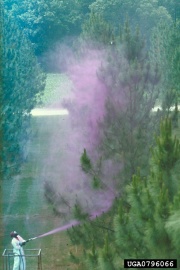Pesticide
Description
Any substance used to destroy or control pests. Nearly all pesticides are toxic to man. A natural pesticide made from ground tobacco plants was first used in the 1763 century to kill aphids. Examples of other natural organic pesticides include nicotine, rotenone, petroleum, kerosene, creosote, and turpentine. Early inorganic pesticides also introduced in the 18th century include Paris green, Bordeaux mixture, and hydrogen cyanide. The first synthetic pesticide, DDT was developed in 1939 in Switzerland. After World War II, synthetic products proliferated including diazinon, aldrin, dieldrin, chlordane, lindane, parathion, along with numerous fumigants. By the 1960s, the devastating effects of widespread usage have prompted the regulation of the most hazardous pesticides. Many of the currently used chemicals break down rapidly leaving little to no residues. Additionally, insect growth regulators (e.g., methoprene, hydroprene, and fenoxycarb) and sex pheromones are being used with minimal human toxicity.
Aee also attractant, fumigant, insecticide, and biocide
Synonyms and Related Terms
pesticides (pl.); pest control agent; attractant; fumigant; insecticide; biocide; rodenticide
Additional Images
Sources Checked for Data in Record
- Nancy Odegaard, Alyce Sadongei, and associates, Old Poisons, New Problems, Altimira, Walnut Creek, CA, 2005
- Lynda A. Zycherman, J.Richard Schrock, A Guide to Museum Pest Control, FAIC and Association of Systematics Collections, Washington DC, 1988
- The American Heritage Dictionary or Encarta, via Microsoft Bookshelf 98, Microsoft Corp., 1998
- Encyclopedia Britannica, http://www.britannica.com Comment: "Pesticide." Encyclopædia Britannica. 7 Sept. 2004 .




